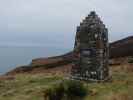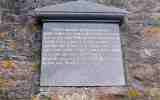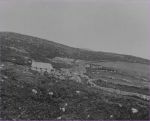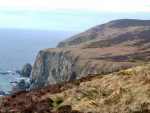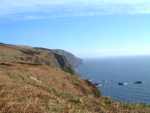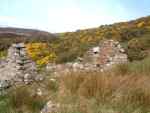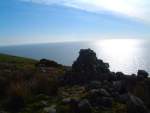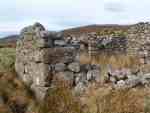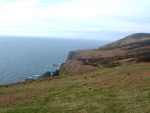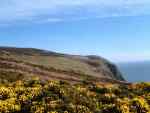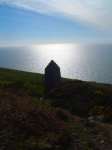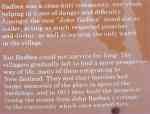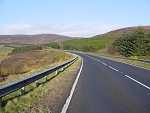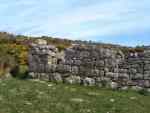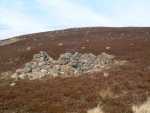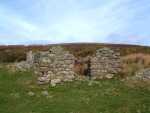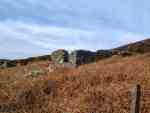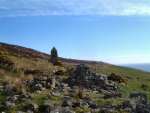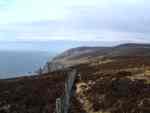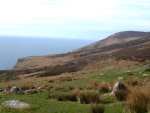 | Caithness.Org | Community | Business | Entertainment | Caithness... | Tourist Info | Site Map |
• Advertising • Chat Room • Contact Us • Kids Links • Links • Messageboard • News - Local & Scottish • News - UK & News Links • About / Contact Us • Submissions |
• Bookshop • Business Index & News • Jobs • Property For Sale • Property For Rent • Shop • Sutherland Business Index |
• Fishing • Fun Stuff • George, The Saga • Horses • Local Galas • Music • Pub Guide • Sport Index • What's On In Caithness |
• General Information • B & Bs • Backpackers • Caravan & Camping • Ferries • Getting Here • Holiday Letting • Hotels • Orkney • Pentland Firth • Sutherland • Taxis |
| N E W S F E E D S >>> |
Badbea
An
early 19th century village near the edge of the cliffs where
people evicted from the nearby
Langwell were sent.
This was a harsh
place to live at that time and many of the people left to go to New
Zealand.
Children
were reputedly tethered in case they wandered off the cliffs.
A monument
to the erected in 1911 and unveiled in 1912 stands as a reminder to this day.
�Letters by John Badbea"
recently acquired by Clan Sinclair Study Centre 1855 - 1860
|
Badbea Monument
- Caithness Waybaggers Walk Ousdale To Berriedale
February 2008
John Gunn -
Died 1876 - From Lynn Craig - Nov 2007 BADBEA By
Joy Corley
Fishing was the main employment of the inhabitants with haddock lying right opposite Badbea. Tons of fish could be landed in a day with fish put aside for the widows with young children - no one wanted for fish from one year�s end to the other.
There was some trifling work to be got occasionally on the estate, but the rate of wages was very low. One shilling per day was the rate for the best worker until 1854. In 1854 the Duke of Portland bought the Estate. If any young man had the courage to go and work beyond the estate his parents would suffer by being turned out of their house and lot at the next term. Smuggling was very common and every house and family in the hamlet had their �browst� or two every year. At one time the excise laws were not very stringent but later when they became stringent the Innkeeper at Berriedale, (now the Estate Office) John Dow would despatch a messenger to Badbea to warn them as the gaugers stationed in Dunbeath always called at the Inn on their way to Badbea. A sight to behold after running three miles to relay the message. Men could then be seen running in all directions, carrying sacks of malt to hide in the hills and rocks. If the dreaded party were successful the find was scattered among the heather or grass but when they were safety out of sight willing hands and nimble fingers gathered what had been so ruthlessly scattered, proving the truth of the saying that there is �a time to scatter and a time to gather that which was scattered�.
When the Atalanta was out of sight the staves lying scattered on the shore were gathered together and handed over to David Badbea (David Sutherland) who held the offices of joiner and cooper and within 24 hours they were all in their former shape and ready for use, whilst willing hands restored the burnt out bothy to its former state. Having said the above many a good quarter of barley was sold by the gauger to the Badbea folks to be converted into Highland whisky, sent to their very door by his own carts, and many a good gallon of whisky made from his own barley did the gauger take in part payment for his victual. Contrary to the above it is said that a drunken person would not be found at Badbea nor was any of its inhabitants heard to utter a profane oath. Perhaps the godly John Sutherland �John Badbea� set a good example by holding meetings or reading in his own house every Sunday when everyone in Badbea and Achnacraig regularly attended. John was assisted a few other godly men in the place Robert Grant, �Polbagh� was one of these and always closed the meeting with a prayer. Although it was the opinion of the older folks that the good earnest man was a shade too long in arriving at the �Amen�. John Badbea (Sutherland) was the only person who sported a watch yet time could be calculated with as much accuracy both by night or day as if every one in the place had a watch or clock. John Badbea (Sutherland) was born at Ousdale in 1788. His father was called James who married Catherine Sutherland. He had a brother Donald who was killed at Waterloo. John spent most of his life at Badbea where he died on 31 August 1864, aged 76 years, and was buried in the old burial ground at Berriedale. The inscription of the tombstone reads, �Erected to the memory of John Sutherland (Badbea) a native of Ousdale who feared the Lord from his youth, and was a lover of good things, sober, just, temperate, holding fast the faithful word as he had been taught. John went to Badbea as a young bachelor to live with his niece Catherine. Later he became a preacher, doctor and counsellor to all, a man of exceptional piety and worth. John was thought to be a man of some means for he would accept no payment from the poor. See Some Letters of John Badbea Sutherland Alexander Robert Sutherland born Badbea in 1806 was brought up by John (Sutherland) Badbea. Mr Alex. Sutherland afterwards emigrated to New Zealand in the ship �Oriental� in 1839 and prospered in the land of his adoption but he never forgot the lessons he was taught at the knees of John Badbea. He was honoured and respected while he lived. Alexander died in New Zealand in 1877 at the age of 71 years. His son �David Sutherland� though born in New Zealand visited Badbea in 1901. Only two tenants remained namely the Widow Enid John Sutherland and John Gunn (who left and went to Langwell Gardens).
|

